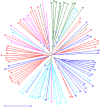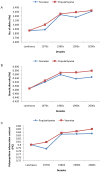Molecular Genetic Diversity of Major Indian Rice Cultivars over Decadal Periods
- PMID: 23805204
- PMCID: PMC3689748
- DOI: 10.1371/journal.pone.0066197
Molecular Genetic Diversity of Major Indian Rice Cultivars over Decadal Periods
Abstract
Genetic diversity in representative sets of high yielding varieties of rice released in India between 1970 and 2010 was studied at molecular level employing hypervariable microsatellite markers. Of 64 rice SSR primer pairs studied, 52 showed polymorphism, when screened in 100 rice genotypes. A total of 184 alleles was identified averaging 3.63 alleles per locus. Cluster analysis clearly grouped the 100 genotypes into their respective decadal periods i.e., 1970s, 1980s, 1990s and 2000s. The trend of diversity over the decadal periods estimated based on the number of alleles (Na), allelic richness (Rs), Nei's genetic diversity index (He), observed heterozygosity (Ho) and polymorphism information content (PIC) revealed increase of diversity over the periods in year of releasewise and longevitywise classification of rice varieties. Analysis of molecular variance (AMOVA) suggested more variation in within the decadal periods than among the decades. Pairwise comparison of population differentiation (Fst) among decadal periods showed significant difference between all the pairs except a few. Analysis of trends of appearing and disappearing alleles over decadal periods showed an increase in the appearance of alleles and decrease in disappearance in both the categories of varieties. It was obvious from the present findings, that genetic diversity was progressively on the rise in the varieties released during the decadal periods, between 1970s and 2000s.
Conflict of interest statement
Figures






References
-
- Christiansen MJ, Andersen SB, Ortiz R (2002) Diversity changes in an intensively bred wheat germplasm during the 20th century. Molecular Breeding 9: 1–11.
-
- Tian QZ, Zhou RH, Jia JZ (2005) Genetic diversity trend of common wheat (Triticum aestivum L.) in China revealed with AFLP markers. Genetic Resources and Crop Evolution 52: 325–331.
-
- White J, Law JR, MacKay I, Chalmers KJ, Smith JSC, et al. (2007) The genetic diversity of UK, US and Australian cultivars of Triticum aestivum measured by DArT markers and considered by genome. Theoretical and Applied Genetics 116: 439–453. - PubMed
-
- Huang X-Q, Wolf M, Ganal MW, Orford S, Koebner RMD, et al. (2007) Did Modern Plant Breeding Lead to Genetic Erosion in European Winter Wheat Varieties? Crop Science 47: 343.
-
- Roussel V, Koenig J, Beckert M, Balfourier F (2004) Molecular diversity in French bread wheat accessions related to temporal trends and breeding programmes. TAG Theoretical and Applied Genetics 108: 920–930. - PubMed
Publication types
MeSH terms
Substances
LinkOut - more resources
Full Text Sources
Other Literature Sources
Miscellaneous

